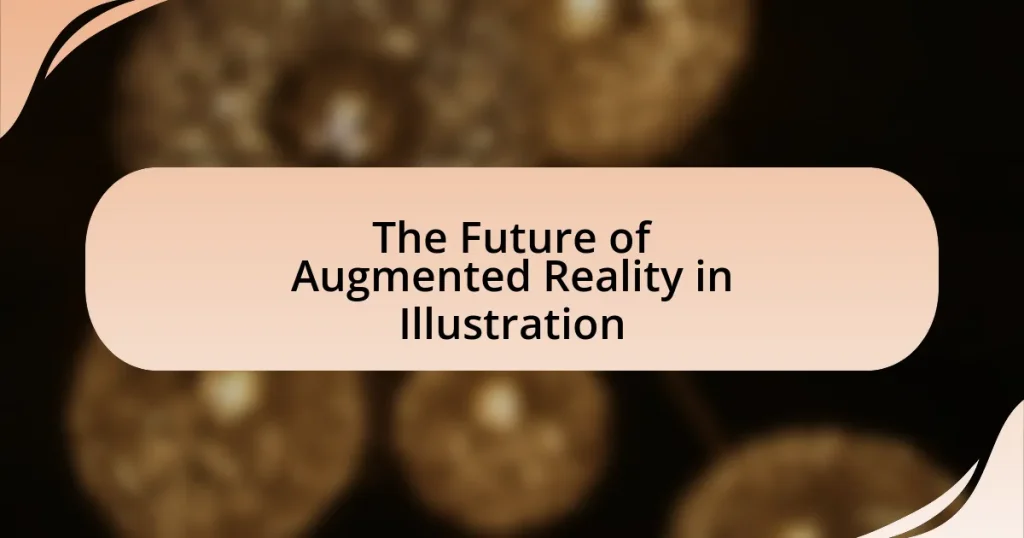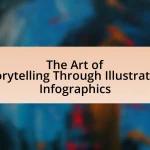The article focuses on the future of augmented reality (AR) in illustration, highlighting its potential for significant growth and integration into creative fields. It discusses current applications of AR in enhancing visual storytelling through interactive experiences, the technologies enabling these advancements, and how artists are incorporating AR into their workflows. The article also explores potential developments, challenges, and the implications of AR for the illustration industry, emphasizing the importance of user experience, collaboration between artists and technologists, and ethical considerations in creating AR content. Overall, it provides a comprehensive overview of how AR is transforming the landscape of illustration and the skills artists need to thrive in this evolving environment.
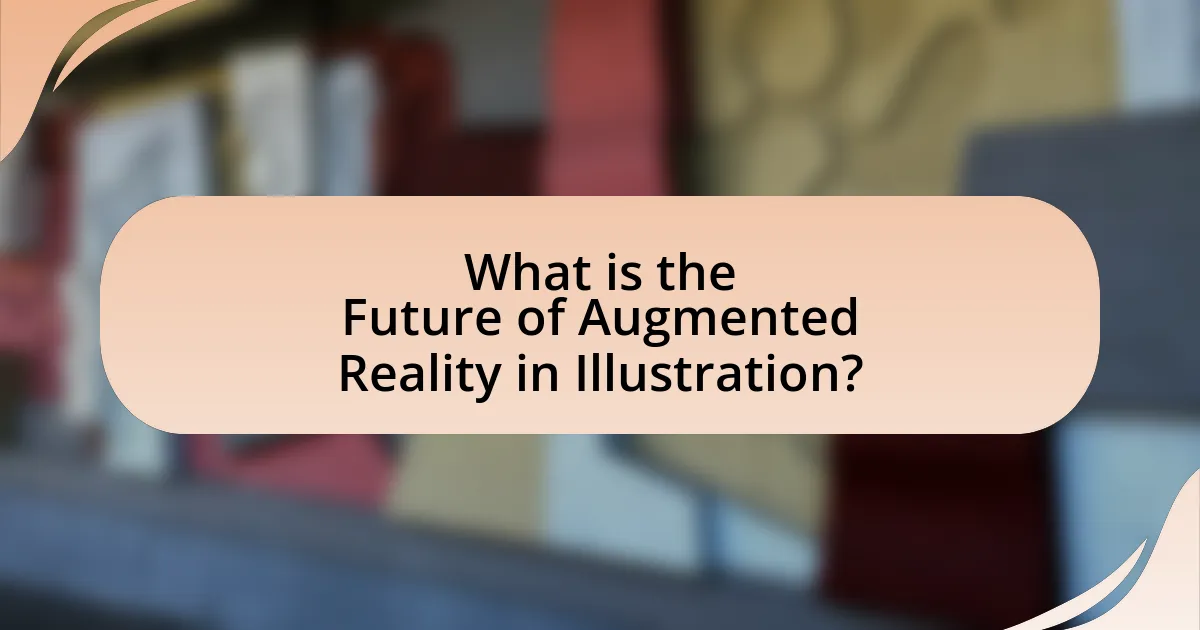
What is the Future of Augmented Reality in Illustration?
The future of augmented reality (AR) in illustration is poised for significant growth, driven by advancements in technology and increasing integration into various creative fields. AR enables illustrators to create immersive experiences that blend digital art with the physical world, enhancing storytelling and engagement. For instance, tools like Adobe Aero and platforms such as Artivive allow artists to animate their illustrations, providing interactive elements that captivate audiences. According to a report by Statista, the AR market is expected to reach $198 billion by 2025, indicating a robust demand for AR applications, including in illustration. This trend suggests that illustrators will increasingly adopt AR to innovate their work, making it more dynamic and accessible to a broader audience.
How is augmented reality currently used in illustration?
Augmented reality is currently used in illustration to create interactive and immersive experiences that enhance visual storytelling. Artists and illustrators utilize AR technology to overlay digital images onto the physical world, allowing viewers to engage with illustrations in a dynamic way. For instance, applications like Adobe Aero enable illustrators to animate their artwork, making it possible for users to see characters come to life or interact with elements in real-time. This integration of AR in illustration not only captivates audiences but also provides a novel platform for artists to showcase their work, as evidenced by projects like the “AR Art Gallery” which allows users to view and interact with art pieces through their smartphones.
What technologies enable augmented reality in illustration?
Technologies that enable augmented reality in illustration include computer vision, depth tracking, and mobile devices equipped with AR software. Computer vision allows devices to interpret and understand visual information from the real world, enabling the overlay of digital illustrations onto physical environments. Depth tracking enhances this experience by measuring the distance between objects, ensuring that virtual elements interact realistically with the real world. Mobile devices, such as smartphones and tablets, utilize AR software like ARKit and ARCore to facilitate these technologies, providing users with accessible platforms for augmented reality experiences in illustration.
How do artists integrate augmented reality into their workflows?
Artists integrate augmented reality (AR) into their workflows by utilizing AR software and tools to enhance their creative processes and engage audiences. They often create digital overlays that interact with physical artworks, allowing viewers to experience additional layers of information or animation through their devices. For instance, artists may use platforms like Adobe Aero or Unity to develop AR experiences that complement their illustrations, providing an immersive storytelling element. This integration not only expands the artistic possibilities but also aligns with trends in interactive art, as evidenced by the increasing number of exhibitions featuring AR components, which have been shown to attract larger audiences and enhance viewer engagement.
What potential developments can we expect in augmented reality for illustration?
Potential developments in augmented reality for illustration include enhanced interactivity, improved realism, and integration with artificial intelligence. Enhanced interactivity will allow users to manipulate illustrated elements in real-time, creating immersive experiences. Improved realism will be achieved through advancements in graphics rendering, making virtual illustrations indistinguishable from physical objects. Integration with artificial intelligence will enable personalized content creation, where AR systems can adapt illustrations based on user preferences and behaviors. These developments are supported by ongoing research in AR technology, such as the work by Azuma et al. (2001) on defining augmented reality and its applications, which highlights the potential for interactive and immersive experiences in various fields, including illustration.
How might advancements in technology influence augmented reality in illustration?
Advancements in technology will significantly enhance augmented reality (AR) in illustration by improving interactivity, realism, and accessibility. For instance, developments in computer vision and machine learning enable more accurate tracking of real-world environments, allowing illustrations to seamlessly integrate with physical spaces. Additionally, the introduction of 5G technology facilitates faster data transmission, which enhances the responsiveness of AR applications, making them more engaging for users. Furthermore, advancements in hardware, such as lighter and more powerful AR glasses, will make AR experiences more comfortable and widely adopted, thereby expanding the reach of illustrated content. These technological improvements collectively contribute to a richer and more immersive experience in augmented reality illustration.
What role will artificial intelligence play in the future of augmented reality illustration?
Artificial intelligence will significantly enhance augmented reality illustration by enabling real-time content generation and personalization. AI algorithms can analyze user preferences and environmental contexts to create tailored visual experiences, making illustrations more relevant and engaging. For instance, AI-driven tools can automatically adapt illustrations based on user interactions, improving the overall user experience. Additionally, advancements in machine learning and computer vision will allow for more sophisticated integration of digital elements into the physical world, facilitating seamless interactions between users and augmented content. This evolution is supported by the increasing adoption of AI technologies in creative industries, as evidenced by a report from McKinsey, which highlights that AI can boost productivity in design processes by up to 30%.
Why is augmented reality important for the future of illustration?
Augmented reality is important for the future of illustration because it enhances the way artists can create and present their work, allowing for immersive experiences that engage audiences more deeply. This technology enables illustrators to overlay digital images onto the real world, providing interactive elements that traditional illustrations cannot offer. For instance, a study by the International Journal of Human-Computer Interaction found that users retain information better when interacting with augmented content compared to static images. This capability not only transforms storytelling but also opens new avenues for marketing, education, and entertainment, making illustrations more dynamic and accessible.
How does augmented reality enhance the storytelling aspect of illustrations?
Augmented reality enhances the storytelling aspect of illustrations by allowing interactive and immersive experiences that engage viewers on a deeper level. This technology enables illustrations to come to life, providing additional layers of narrative through animations, sound, and interactive elements that traditional illustrations cannot offer. For instance, a static illustration of a historical event can be augmented with 3D models and audio narratives, allowing users to explore the scene from multiple perspectives and gain a richer understanding of the context. Research indicates that interactive storytelling can increase retention and emotional engagement, as evidenced by a study published in the Journal of Interactive Media, which found that users who interacted with augmented content reported a 30% higher emotional connection to the story compared to traditional formats.
What advantages does augmented reality offer to illustrators compared to traditional methods?
Augmented reality offers illustrators enhanced interactivity and immersive experiences compared to traditional methods. This technology allows illustrators to create dynamic visuals that can be viewed in real-world contexts, enabling users to engage with illustrations in a three-dimensional space. For instance, AR applications can overlay digital illustrations onto physical environments, allowing for a more engaging storytelling experience. Research indicates that 70% of consumers prefer to engage with content that incorporates AR, highlighting its effectiveness in capturing attention and enhancing user experience. Additionally, AR tools can facilitate real-time feedback and collaboration, streamlining the creative process and allowing for immediate adjustments based on viewer interaction.
How can artists prepare for the future of augmented reality in illustration?
Artists can prepare for the future of augmented reality in illustration by developing skills in digital tools and understanding AR technology. Familiarity with software such as Unity or ARKit enables artists to create immersive experiences that blend traditional illustration with digital enhancements. Additionally, studying user interaction and experience design is crucial, as AR relies heavily on how users engage with visual content in real-world environments. Research indicates that the AR market is projected to reach $198 billion by 2025, highlighting the growing demand for AR content. By staying informed about technological advancements and trends in AR, artists can position themselves effectively in this evolving field.
What skills should illustrators develop to thrive in an augmented reality landscape?
Illustrators should develop skills in 3D modeling, interactive design, and an understanding of augmented reality (AR) technologies to thrive in an augmented reality landscape. Mastery of 3D modeling allows illustrators to create immersive visuals that can be experienced in AR environments, while interactive design skills enable them to craft engaging user experiences that respond to user interactions. Additionally, a solid understanding of AR technologies, including software and hardware capabilities, is essential for effectively integrating illustrations into AR applications. These skills are increasingly relevant as the AR market is projected to reach $198 billion by 2025, highlighting the growing demand for skilled professionals in this field.
How can artists stay updated with emerging augmented reality tools and trends?
Artists can stay updated with emerging augmented reality tools and trends by actively engaging with industry publications, attending relevant conferences, and participating in online forums. Industry publications such as “Augmented Reality News” and “VRScout” provide insights into the latest developments and tools. Conferences like the Augmented World Expo (AWE) showcase cutting-edge technologies and offer networking opportunities with other professionals. Online forums and social media platforms, such as Reddit and LinkedIn groups focused on augmented reality, facilitate discussions and knowledge sharing among artists and developers. These methods ensure that artists remain informed about advancements and can adapt their practices accordingly.
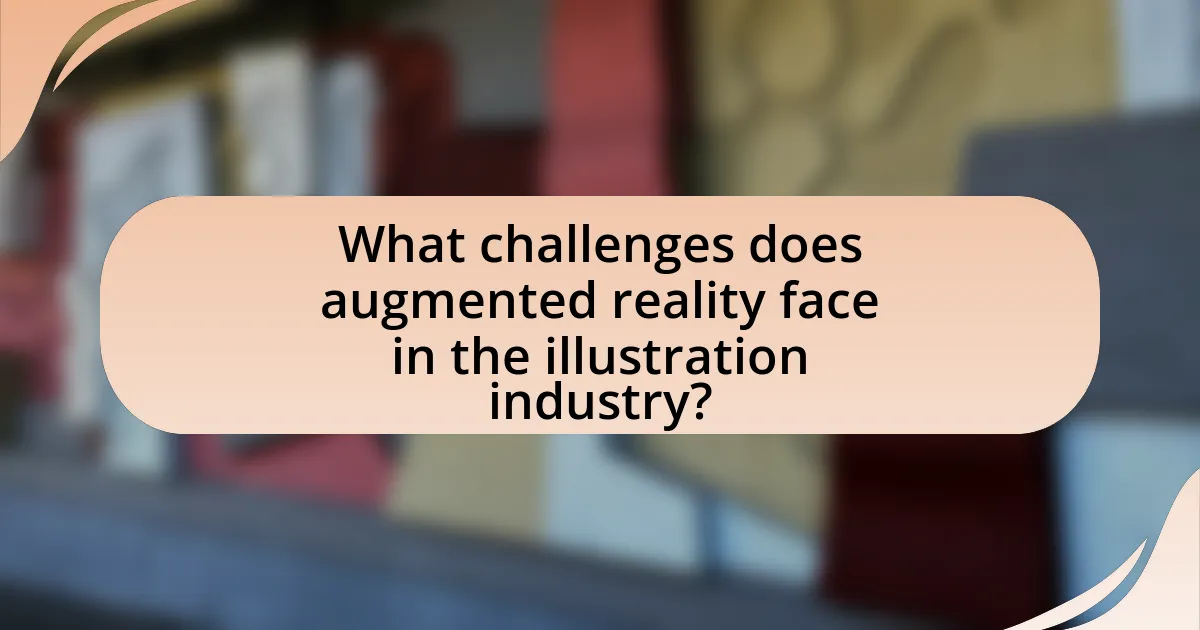
What challenges does augmented reality face in the illustration industry?
Augmented reality (AR) faces several challenges in the illustration industry, primarily including technological limitations, user adoption, and content creation complexities. Technological limitations involve the need for high-quality hardware and software that can support AR experiences, which can be cost-prohibitive for many illustrators. User adoption is hindered by a lack of familiarity with AR technology among both artists and consumers, leading to resistance in integrating AR into traditional illustration practices. Additionally, content creation complexities arise from the necessity to design illustrations that are not only visually appealing but also interactive and compatible with various AR platforms, which requires specialized skills and knowledge. These challenges collectively impede the widespread implementation of AR in the illustration industry.
What are the technical limitations of augmented reality in illustration?
The technical limitations of augmented reality in illustration include issues such as limited field of view, tracking inaccuracies, and hardware constraints. Limited field of view restricts the user’s ability to see the augmented content fully, often resulting in a disjointed experience. Tracking inaccuracies can lead to misalignment of digital illustrations with real-world objects, diminishing the effectiveness of the augmented experience. Additionally, hardware constraints, such as processing power and battery life of devices, can hinder the performance and quality of augmented reality applications, making them less reliable for detailed illustrations. These limitations have been documented in studies, such as the research by Billinghurst and Dunser (2012), which highlights the challenges faced in achieving seamless integration of augmented content in real-world environments.
How do user experience issues affect the adoption of augmented reality in illustration?
User experience issues significantly hinder the adoption of augmented reality in illustration by creating barriers to usability and engagement. When users encounter difficulties such as complex navigation, poor interface design, or lack of intuitive interactions, they are less likely to embrace augmented reality applications. Research indicates that 70% of users abandon applications due to frustrating experiences, highlighting the critical role of user experience in technology adoption. Furthermore, if augmented reality tools do not seamlessly integrate into existing workflows or fail to deliver clear value, users may perceive them as unnecessary, further impeding their acceptance in the illustration field.
What are the costs associated with implementing augmented reality in illustration projects?
The costs associated with implementing augmented reality in illustration projects typically range from $10,000 to $500,000, depending on the complexity and scale of the project. This cost includes expenses for software development, hardware requirements, content creation, and ongoing maintenance. For instance, developing a custom AR application can cost between $20,000 and $150,000, while licensing existing AR platforms may incur fees from $1,000 to $10,000 annually. Additionally, high-quality 3D modeling and animation, essential for effective AR experiences, can add another $5,000 to $100,000 to the overall budget. These figures are supported by industry reports indicating that AR project costs vary significantly based on the desired features and the level of interactivity required.
How can these challenges be overcome?
To overcome the challenges in the future of augmented reality in illustration, developers must focus on enhancing user experience through improved technology and accessibility. This can be achieved by investing in more intuitive interfaces and ensuring compatibility across various devices, which will facilitate broader adoption. For instance, research by the International Data Corporation indicates that the augmented reality market is expected to grow significantly, suggesting that advancements in technology will likely address current limitations. Additionally, fostering collaboration between artists and technologists can lead to innovative solutions that enhance the creative process and address specific challenges faced by illustrators in utilizing augmented reality effectively.
What innovations are being developed to address technical limitations?
Innovations being developed to address technical limitations in augmented reality (AR) for illustration include advancements in hardware, software, and user interface design. For instance, improvements in AR glasses, such as lighter materials and enhanced battery life, enable longer usage periods and greater comfort for artists. Additionally, software innovations like real-time rendering and improved tracking algorithms enhance the accuracy and responsiveness of AR applications, allowing for seamless integration of digital illustrations into the physical environment. Research from the University of Southern California highlights that these advancements can significantly reduce latency and improve user experience, making AR tools more effective for illustrators.
How can collaboration between artists and technologists improve augmented reality experiences?
Collaboration between artists and technologists can significantly enhance augmented reality experiences by merging creative vision with technical expertise. Artists contribute imaginative concepts and visual storytelling, while technologists provide the necessary tools and frameworks to bring these ideas to life. For instance, the integration of 3D modeling and animation techniques by artists with software development skills from technologists results in more immersive and interactive AR applications. A study by the University of Southern California found that interdisciplinary teams produce more innovative solutions, demonstrating that such collaborations can lead to richer user experiences and increased engagement in augmented reality environments.
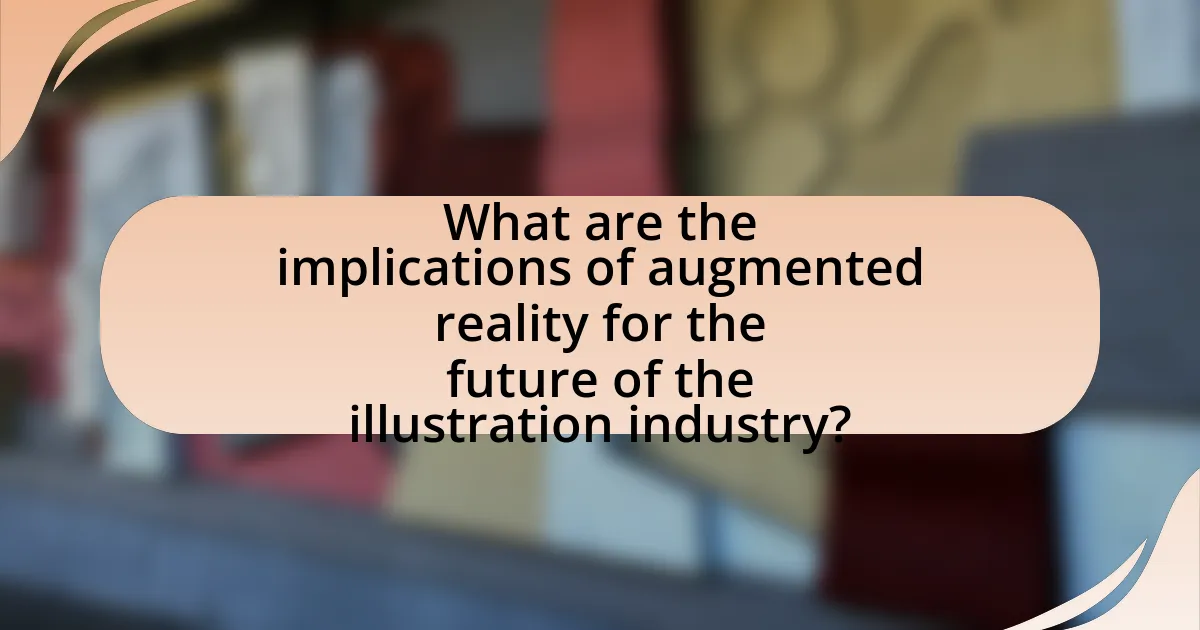
What are the implications of augmented reality for the future of the illustration industry?
Augmented reality (AR) will significantly transform the illustration industry by enhancing interactivity and engagement in visual storytelling. AR allows illustrators to create immersive experiences where users can interact with illustrations in real-time, leading to a more dynamic and personalized consumption of art. For instance, studies show that AR applications can increase user engagement by up to 70%, as users are more likely to interact with content that offers a three-dimensional experience. This shift will require illustrators to adapt their skills, incorporating digital tools and AR technologies into their workflows, ultimately expanding their creative possibilities and market reach.
How will augmented reality change the way audiences interact with illustrations?
Augmented reality will fundamentally transform audience interaction with illustrations by enabling immersive, interactive experiences that blend digital content with the physical world. This technology allows users to engage with illustrations in real-time, enhancing their understanding and emotional connection to the artwork. For instance, studies have shown that AR applications can increase user engagement by up to 70%, as audiences can manipulate and explore illustrations from various angles and perspectives. This shift not only enriches the storytelling aspect of illustrations but also fosters a more participatory culture, where viewers become active contributors rather than passive observers.
What new markets could emerge from the integration of augmented reality in illustration?
The integration of augmented reality in illustration could lead to the emergence of several new markets, including interactive educational tools, immersive advertising experiences, and enhanced gaming environments. Interactive educational tools can utilize AR to create engaging learning experiences, allowing students to visualize complex concepts in real-time. The global AR education market is projected to reach $5.3 billion by 2023, indicating significant demand. Immersive advertising experiences can leverage AR to create captivating campaigns that allow consumers to interact with products virtually, enhancing brand engagement. The AR advertising market is expected to grow to $13.3 billion by 2025, showcasing its potential. Enhanced gaming environments can offer players a more immersive experience by integrating illustrations into the real world, with the AR gaming market anticipated to reach $198 billion by 2025. These statistics highlight the substantial opportunities for new markets driven by augmented reality in illustration.
How might augmented reality influence the educational aspects of illustration?
Augmented reality (AR) can significantly enhance the educational aspects of illustration by providing interactive and immersive learning experiences. AR allows students to visualize complex concepts in a three-dimensional space, making abstract ideas more tangible. For instance, a study by the University of Maryland found that students using AR tools demonstrated a 30% improvement in retention of information compared to traditional methods. This technology enables learners to engage with illustrations in real-time, fostering a deeper understanding of artistic techniques and principles. Furthermore, AR can facilitate collaborative learning, as multiple users can interact with the same digital illustrations simultaneously, promoting teamwork and communication skills.
What best practices should illustrators follow when using augmented reality?
Illustrators should prioritize user experience and interactivity when using augmented reality. This involves designing intuitive interfaces that engage users effectively, ensuring that the augmented elements enhance rather than distract from the artwork. Additionally, illustrators should consider the context in which the AR experience will be used, tailoring content to fit various environments and user scenarios. For instance, research indicates that AR applications that align closely with user expectations and real-world contexts lead to higher engagement rates. Furthermore, testing AR experiences with real users can provide valuable feedback, allowing illustrators to refine their designs based on actual user interactions.
How can illustrators effectively market their augmented reality projects?
Illustrators can effectively market their augmented reality projects by leveraging social media platforms, creating engaging content, and collaborating with influencers. Social media, particularly platforms like Instagram and TikTok, allows illustrators to showcase their AR projects through visually appealing posts and videos, reaching a broad audience. Engaging content, such as behind-the-scenes looks or tutorials, can enhance viewer interest and interaction. Collaborating with influencers who have a strong following in the art or technology sectors can further amplify visibility and credibility, as influencers can introduce the projects to their audience, leading to increased engagement and potential sales.
What ethical considerations should artists keep in mind when creating augmented reality illustrations?
Artists should prioritize user consent and privacy when creating augmented reality illustrations. This involves ensuring that users are aware of how their data may be used and obtaining explicit permission before incorporating personal information or location data into the artwork. Additionally, artists must consider the potential for misrepresentation or manipulation of reality, as augmented reality can alter perceptions and may lead to misinformation. Ethical practices also include respecting cultural sensitivities and avoiding appropriation, ensuring that the content is inclusive and does not perpetuate stereotypes. These considerations are crucial as they align with the growing emphasis on ethical standards in digital art and technology, as highlighted by the increasing number of guidelines and frameworks established by organizations in the creative industry.
